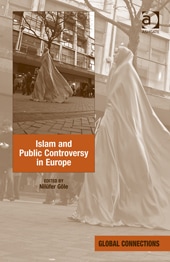Nilüfer Göle, ed. Islam and Public Controversy in Europe. Farnham: Ashgate, 2013. 262 pages. ISBN: 978-1-472-41313-0
Nowadays Islam plays a pivotal role in the social reality of Europe. The growing number of Muslims living within European countries has raised important questions related to their social and legal integration. The aim of the book, edited by Nilüfer Göle ‘Islam and Public Controversy in Europe’, is to provide an analysis of the effects related to the presence of Islam in Europe, highlighting its main aspects and problems. This volume is the result of two international conferences that were held in Paris in October 2011 and May/June 2012. The purpose of these conferences was to analyse the ways in which European public spheres have been shaped by controversies related to the topic of religious diversity.
In this regard, the notions of public sphere and controversy represent two basic epistemological tools that the contributors of this volume have adopted in their analysis. While the notion of public sphere is employed to identify the space in which Muslims gain visibility, and where the confrontation between Islam and Europe takes place, the notion of controversy refers to those issues that this confrontation raises.As Göle interestingly points out, the notion of controversy is used to study ‘the emergence of new actors in unexpected places.’ (Göle, Chapter 1).

In this case, the core of the issue consists in the difficulty of establishing a clear line between the legitimacy to declare certain customs as illegal, and the duty to respect the religious diversity that Islam embodies.
It is under this perspective that, within ‘multicultural’ Europe, Muslims play a role of significant otherness. This fact implies that they are perceived as an element of diversity,whose traditions and (moral) rules cannot therefore be integrated within the different European legal systems. In highlighting the key aspects of this issue, Islam and Public Controversy in Europe challenges this position showing that problems related to the complete integration of Muslims, depend on the mistaken picture of Islam that Europeans hold. What is at stake, therefore, is not just a matter of social and legal integration, but also concerns how Islam is perceived and defined in Europe. A clear example is represented by controversies over the construction of mosques.
Unlike other places of worship, such as churches or synagogues that are deemed inherent to European tradition, mosques are perceived as an element that is very alien to European culture (Avcıoğlu, Chapter 5). The opposition against the construction of mosques becomes even more vehement when it concerns the erection of minarets. This is due to the fact that they are perceived as the symbolic representation of the radicalization of Islam within European territory (Allevi, Chapter 6).
What these controversies underline is that Muslims are often perceived and depicted as a religious diversity that is too different to be part of Europe.
This particular attitude may force autochthonous Muslims of Europe, like the Bosniaks for instance, to abandon their Islamic roots in order to become ‘European’ (Velioğlu, Chapter 19). As Tolan argues in chapter nine, the way in which Islam is portrayed in Europe is the result of a ‘deforming mirror’ that embodies more the fear of Islam, rather than its actual picture.
However, the relation between Us/Them, which characterizes every encounter with diversity, is not the only issue related to the presence of Islam in Europe. Muslims, either those who are immigrants or those who were born in Europe, face the challenge of respecting European laws without transgressing their religious duties. Is it therefore possible for Muslims to conciliate Islamic rules with European ones? This question deals directly with issues related to the problem of integration.
What the book seems to suggest is that this integration may be achieved through the adoption of some cultural notions that belong to either European or Islamic tradition.
Laegard (Chapter 10) discusses the case of Danish cartoons to show how this and other non-legal controversies can be approached through the concept of ‘civility’, which implies setting up ‘social interactions with strangers in a non-violent way.’ This perspective is of great interest since it emphasises the importance of equality in diversity – giving the same position to others’ claims. Similarly, the concept of halal is employed as cultural means to enable the social integration of Muslims in the everyday reality of European societies, covering different aspects of cultural and social life (Yassine, Chapter 14).
Along with its legal and social aspects, the process of integration has to also deal with a specific imaginary embedded in the historical coexistence of Christianity, Judaism, and Islam in Medieval Europe. On the one hand, the historical Islamic heritage of Spain has been employed to facilitate the integration of Muslims (Hirschkind, Chapter 18), while on the other hand, this past religious pluralism is challenged by showing that it was less harmonious than it was depicted (Anidjar, Chapter 17). In focusing it’s analysis on issues that spring from the interaction between Muslims and European citizens or institutions, this book highlights specific features and problems related to a Muslim presence in Europe. Despite the contributors of this volume dealing with different case studies, they all show that an analysis of the process of integration cannot be focused solely on its legal aspects. Rather, it has to also consider those problems related to the implementation and fulfillment of daily duties and needs. It is in this regard that the Europeanization, as Göle called it (p.6), of Islamic terms such as halal or Shari’a becomes relevant. Since it represents an attempt to conciliate Muslim traditions with European standards of behaviors, posing a serious challenge to Islamophobic and xenophobic movements.
Overall, this book is a necessary read for those who are interested in topics related to religious pluralism, immigration, socio-legal integration, and Muslim diaspora. However, due to the clarity of its exposition, scholars and students who are not familiar with the above-mentioned topics will benefit from reading this volume.







